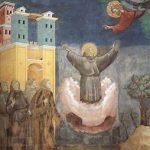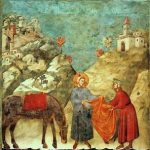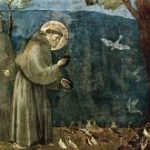I happened to find myself in Assisi on the day of the international School Strikes demanding action on climate change, led by the Swedish teenager, Greta Thunberg; and I felt that the theme fitted well with the Franciscan ethos that is still evident in Assisi.
There are various reasons why a visit to the Church of St Francis in Assisi is inspiring, the chief one, as far as I am concerned, being because of the number and quality of the paintings by some of my favourite artists, that adorn the walls, including Cimabue’s portrait of St Francis, which forms part of his majestic painting of the Virgin and Child with angels.  Nowhere else can one find so many frescoes by Giotto and Cimabue and I could (and do when possible) spend many hours contemplating the vision of these artists. This does not mean, however, that I am entirely uncritical of the treatment of all the subjects portrayed.
Nowhere else can one find so many frescoes by Giotto and Cimabue and I could (and do when possible) spend many hours contemplating the vision of these artists. This does not mean, however, that I am entirely uncritical of the treatment of all the subjects portrayed.
For most of us, Francis is renowned for his love of nature and his respect for all Creation, and at a time when so much of our natural environment is bespoiled or at risk of extinction, these aspects of his story are more attractive than ever. Born into a well-to-do family and  initially living a life of pleasure and ease, Francis had an epiphany that caused him to give up all worldly wealth and privilege to become a humble friar. It may well be that he appeared at a point in history when his message was needed, and he simply ignited a fuse that was ready to burst into life; but he was also clearly a charismatic character, who quickly attracted huge numbers of followers and gradually formed what became known as the Franciscan Order. As is often the case with these special personalities, stories accrued around the basic facts of his life, and a number of miracles were ascribed to him both during his lifetime and afterwards.
initially living a life of pleasure and ease, Francis had an epiphany that caused him to give up all worldly wealth and privilege to become a humble friar. It may well be that he appeared at a point in history when his message was needed, and he simply ignited a fuse that was ready to burst into life; but he was also clearly a charismatic character, who quickly attracted huge numbers of followers and gradually formed what became known as the Franciscan Order. As is often the case with these special personalities, stories accrued around the basic facts of his life, and a number of miracles were ascribed to him both during his lifetime and afterwards.
The fact that St Francis was a remarkable and inspiring man doesn’t mean that we have to accept the veracity of all the stories portrayed, lock, stock and barrel, though the fact that some of these are far-fetched is not necessarily the fault of the artist, who was simply reproducing myths and legends that were handed down through haggiography or folklore.
The lower basilica in Assisi contains twenty eight frescoes painted either entirely by Giotto or, possibly in some cases, by his associates. These images relate stories from the life of St Francis, the majority of which are more or less credible, while one or two are rather less so. Among the examples of these rather more ‘magical miracles’, I would include the fresco that shows the brothers in Rivotorto observing Francis riding about in a fiery chariot, when he was at the time, in fact, safely earthbound and praying in Assisi. Then, in another picture, the artist portrays the friars watching Francis ascending heavenward in a cloud.

In fact, the life St Francis is so inspiring in itself that there are not as many far-fetched miracles portrayed here as is the case with some of the other saints. To paint Francis hearing a voice speaking to him from the crucifix does not cross the credibility line because it is not implied that the voice would have been audible to anyone else. And many of the other images show striking and unusual events that are not beyond the bounds of possibility, such as Francis preaching confidently before Pope Honorius III, Francis giving his cloak to a poor and destitute nobleman, Francis returning his clothes and possessions to his father or even, with a touch of poetic license, Francis preaching to the birds.


But the miracles that impress me most in the story of this humble saint, also handed down to us in the story of St Francis, don’t relate magical incidents, but the sort of miracles we are more likely to encounter ourselves. Those that are illustrated here include the following:
- The change of life of a wealthy, pleasure-seeking young man who voluntarily embraces poverty and begins to live for others.
- The way in which the force of Francis’s personality and holiness was able to make people feel better by being in contact with him – so giving rise to successful faith healing.
- His love of, and respect for the natural world, celebrated so beautifully in his Canticle of the Sun.
- The huge movement that exploded as thousands of people flocked to Francis to hear his simple message that clearly made sense to them. Perhaps it is not too far-fetched to consider that this miracle is mirrored slightly in recent times with the millions of young people who have responded so quickly to the clear and urgent message of Greta Thunberg and followed her in her campaign against the greed that is one of the causes of climate change.
- And finally, the miracle of the way in which Francis was able to gain the attention and respect of popes, so that they listened to him. Again, this has echoes in the way that the Swedish teenager has gained the attention of some of the more enlightened world leaders, making them aware of the mortal danger we are facing if we do not change our lifestyles.
As well as these miracles, illustrated in the frescoes of the life of St Francis, I believe that we frequently witness miracles in our daily lives, but sometimes fail to realise the wonder of what we are seeing. The fact that a tiny seed can fall into the earth then grow into a mighty tree is nothing short of a miracle; the birth of a baby is a miracle; reconciliation between people who have been in conflict is a miracle, and love that lasts through thick and thin is a miracle.
 And, as I have mentioned, it is nothing short of a miracle that a young teenager can motivate so many people all around the world, to rise up and demand action on climate change, and can also be invited to meet some of the movers and shakers of the world and speak with authority at international events.
And, as I have mentioned, it is nothing short of a miracle that a young teenager can motivate so many people all around the world, to rise up and demand action on climate change, and can also be invited to meet some of the movers and shakers of the world and speak with authority at international events.
Having recognised these as miracles, I am left wondering whether there is any hope that we might witness an even greater miracle that will save the planet before it is too late. Inspired by a 13th century itinerant preacher, can we, perhaps, hope for the miracle that would bring about the agreement of world leaders to make immediate and radical adjustments to policy and commerce, along with the even greater miracle that would lead all of us to love and respect our environment to such an extent that we are prepared to change our behaviour and our lifestyles in whatever ways are necessary for the survival life on earth?
Comments closed